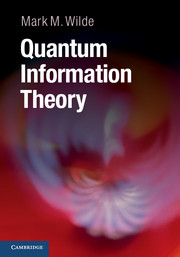Book contents
- Frontmatter
- Contents
- How To Use This Book
- Acknowledgments
- Part I Introduction
- Part II The Quantum Theory
- Part III Unit Quantum Protocols
- Part IV Tools of Quantum Shannon Theory
- Part V Noiseless Quantum Shannon Theory
- 17 Schumacher Compression
- 18 Entanglement Concentration
- Part VI Noisy Quantum Shannon Theory
- Appendix A Miscellaneous Mathematics
- Appendix B Monotonicity of Quantum Relative Entropy
- References
- Index
17 - Schumacher Compression
from Part V - Noiseless Quantum Shannon Theory
Published online by Cambridge University Press: 05 May 2013
- Frontmatter
- Contents
- How To Use This Book
- Acknowledgments
- Part I Introduction
- Part II The Quantum Theory
- Part III Unit Quantum Protocols
- Part IV Tools of Quantum Shannon Theory
- Part V Noiseless Quantum Shannon Theory
- 17 Schumacher Compression
- 18 Entanglement Concentration
- Part VI Noisy Quantum Shannon Theory
- Appendix A Miscellaneous Mathematics
- Appendix B Monotonicity of Quantum Relative Entropy
- References
- Index
Summary
One of the fundamental tasks in classical information theory is the compression of information. Given access to many uses of a noiseless classical channel, what is the best that a sender and receiver can make of this resource for compressed data transmission? Shannon's compression theorem demonstrates that the Shannon entropy is the fundamental limit for the compression rate in the IID setting (recall the development in Section 13.4). That is, if one compresses at a rate above the Shannon entropy, then it is possible to recover the compressed data perfectly in the asymptotic limit, and otherwise, it is not possible to do so. This theorem establishes the prominent role of the entropy in Shannon's theory of information.
In the quantum world, it very well could be that one day a sender and a receiver would have many uses of a noiseless quantum channel available, and the sender could use this resource to transmit compressed quantum information. But what exactly does this mean in the quantum setting? A simple model of a quantum information source is an ensemble of quantum states {pX(x), ∣ψx⟩}, i.e., the source outputs the state ∣ψx⟩ with probability pX(x), and the states {∣ψx⟩} do not necessarily have to form an orthonormal basis. Let us suppose for the moment that the classical data x is available as well, even though this might not necessarily be the case in practice. A naive strategy for compressing this quantum information source would be to ignore the quantum states coming out, handle the classical data instead, and exploit Shannon's compression protocol from Section 13.4.
- Type
- Chapter
- Information
- Quantum Information Theory , pp. 417 - 428Publisher: Cambridge University PressPrint publication year: 2013
- 1
- Cited by

